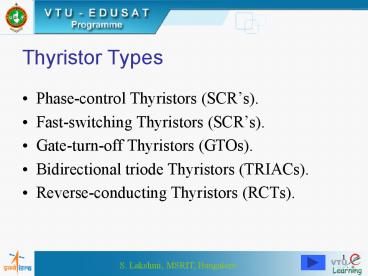Thyristor Types - PowerPoint PPT Presentation
1 / 30
Title:
Thyristor Types
Description:
S. Lakshmi, MSRIT, Bangalore. 2. Static induction Thyristors (SITHs) ... S. Lakshmi, MSRIT, Bangalore. 16. Disadvantages of GTOs. On-state voltage drop is more. ... – PowerPoint PPT presentation
Number of Views:3265
Avg rating:3.0/5.0
Title: Thyristor Types
1
Thyristor Types
- Phase-control Thyristors (SCRs).
- Fast-switching Thyristors (SCRs).
- Gate-turn-off Thyristors (GTOs).
- Bidirectional triode Thyristors (TRIACs).
- Reverse-conducting Thyristors (RCTs).
1
2
- Static induction Thyristors (SITHs).
- Light-activated silicon-controlled rectifiers
(LASCRs). - FET controlled Thyristors (FET-CTHs).
- MOS controlled Thyristors (MCTs).
2
3
Phase Control Thyristor
- These are converter thyristors.
- The turn-off time tq is in the order of 50 to
100?sec. - Used for low switching frequency.
- Commutation is natural commutation
- On state voltage drop is 1.15V for a 600V device.
3
4
- They use amplifying gate thyristor.
4
5
Fast Switching Thyristors
- Also called inverter thyristors.
- Used for high speed switching applications.
- Turn-off time tq in the range of 5 to 50?sec.
- On-state voltage drop of typically 1.7V for
2200A, 1800V thyristor. - High dv/dt and high di/dt rating.
5
6
Bidirectional Triode Thyristors (TRIAC)
6
7
Mode-I Operation
- MT2 Positive,
- Gate Positive
7
8
Mode-II Operation
- MT2 Positive,
- Gate Negative
8
9
Mode-III Operation
- MT2 Negative,
- Gate Positive
9
10
Mode-IV Operation
- MT2 Negative,
- Gate Negative
10
11
Triac Characteristics
11
12
Gate Turn-off Thyristors
- Turned on by applying positive gate signal.
- Turned off by applying negative gate signal.
- On state voltage is 3.4V for 550A, 1200V GTO.
- Controllable peak on-state current ITGQ is the
peak value of on-state current which can be
turned-off by gate control.
12
13
13
14
Advantages over SCRs
- Elimination of commutating components.
- Reduction in acoustic electromagnetic noise due
to elimination of chokes. - Faster turn-off, therefore can be used for higher
switching frequencies. - Improved efficiency of converters.
14
15
Advantages over BJTs
- Higher voltage blocking capabilities.
- High on-state gain.
- High ratio of peak surge current to average
current. - A pulsed gate signal of short duration only is
required.
15
16
Disadvantages of GTOs
- On-state voltage drop is more.
- Due to multi cathode structure higher gate
current is required. - Gate drive circuit losses are more.
- Reverse blocking capability is less than its
forward blocking capability.
16
17
Reverse Conducting Thyristors
17
18
- Anti-parallel diode connected across SCR on the
same silicon chip. - This diode clamps the reverse blocking voltage to
1 or 2V. - RCT also called Asymmetrical Thyristor (ASCR).
- Limited applications.
18
19
Static Induction Thyristors
- Turned-on by applying positive gate voltage.
- Turned-off by applying negative gate voltage.
- Minority carrier device.
- Low on-state resistance low voltage drop.
- Fast switching speeds high dv/dt high di/dt
capabilities.
19
20
- Switching time in order of 1 to 6 ?sec.
- The rating can go upto 2500V / 500A.
- Process sensitive.
20
21
Light-Activated Silicon Controlled Rectifiers
- Turned-on by direct light radiation on silicon
wafer. - Gate structure is sensitive for triggering from
practical light sources. - Used in high voltage and high current
applications. Example HVDC transmission, Static
reactive power compensation.
21
22
- Offers complete electrical isolation between
light triggering source power circuit. - Rating could be has high as 4KV / 1500A.
- di/dt rating is 250A / ?sec.
- dv/dt rating is 2000V / ?sec.
22
23
FET Controlled Thyristors
- Combines a MOSFET a thyristor in parallel as
shown. - High switching speeds high di/dt dv/dt.
23
24
- Turned on like conventional thyristors.
- Cannot be turned off by gate control.
- Application of these are where optical firing is
to be used.
24
25
MOS-Controlled Thyristor
- New device that has become commercially
available. - Basically a thyristor with two MOSFETs built in
the gate structure. - One MOSFET for turning ON the MCT and the other
to turn OFF the MCT.
25
26
Structure
26
27
Equivalent Circuit
27
28
Features
- Low on-state losses large current capabilities.
- Low switching losses.
- High switching speeds achieved due to fast
turn-on turn-off. - Low reverse blocking capability.
28
29
- Gate controlled possible if current is less than
peak controllable current. - Gate pulse width not critical for smaller device
currents. - Gate pulse width critical for turn-off for larger
currents.
29
30
Thank you .
30

